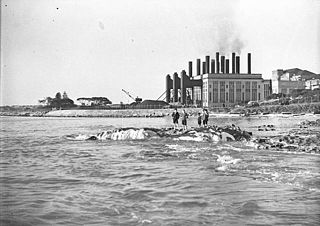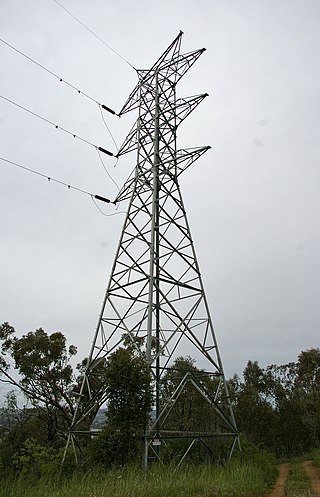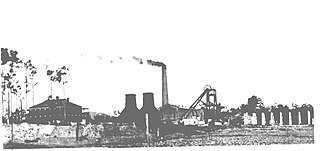
The White Bay Power Station is a heritage listed former coal-fired power station on a 38,000 m2 (410,000 sq ft) site in White Bay, in the suburb of Rozelle, 3 km (2 mi) from Sydney in New South Wales, Australia.

Eraring Power Station is a coal-fired power station consisting of four 720 MW Toshiba steam-driven turbo-alternators for a combined capacity of 2,880 MW. The station is located near the township of Dora Creek, on the western shore of Lake Macquarie, New South Wales, Australia and is owned and operated by Origin Energy. It is Australia's largest power station. The plant has two smokestacks rising 200 m (656 ft) in height. It is slated for closure by mid-2025, after a failed attempt to sell the loss making power station back to the state government.

Munmorah Power Station is a demolished coal-fired power station with four 350 MW English Electric steam driven turbo-alternators for a combined capacity of 1,400 MW. The station was located near Doyalson, on the shores of Lake Munmorah, New South Wales, Australia and was owned and operated by Delta Electricity, a company owned by the New South Wales Government.

Vales Point Power Station is one of two operating coal fired power stations on the shores of Lake Macquarie, New South Wales. Vales Point is located on the southern shore of the lake, near the township of Mannering Park. It has two steam turbines, with a total generating capacity of 1,320 MW (1,770,000 hp) of electricity.

Bayswater Power Station is a bituminous (black) coal-powered thermal power station with four 660 megawatts (890,000 hp) Tokyo Shibaura Electric (Japan) steam driven turbo alternators for a combined capacity of 2,640 megawatts (3,540,000 hp). Commissioned between 1985 and 1986, the station is located 16 kilometres (10 mi) from Muswellbrook, and 28 km (17 mi) from Singleton in the Hunter Region of New South Wales, Australia.

Portishead Power Station refers to a series of two coal and oil-fired power stations which operated in the dock area of Portishead in Somerset, South West England, between 1929 and 1982.

Spencer Street Power Station was a Victorian era coal and (later) oil-fired power station which operated on Spencer Street in central Melbourne, Victoria, Australia. The station was opened in 1894 in order to power electric street lights, then supplied power to the city's residents, as well as being a wholesale supplier to other municipal distributors. It came under the management of the State Electricity Commission of Victoria in 1941. By the 1960s the capacity of the station reached 109 MW, but was used only for peak load. The station was closed in 1982 after becoming redundant. Eventually deemed an eyesore, demolition commenced in 2006 and was completed in 2008, and a large residential and retail development called Upper West Wide was completed by 2016.

The Newport Power Station was a complex of power stations located on the west bank of the Yarra River, approximately 6 km south-west of Melbourne, Victoria, Australia, in the suburb of Newport. Newport A, B, and C were coal-fired plants which operated at the site between 1919 and the 1980s, and were claimed to be the largest power station in the southern hemisphere in 1953 with 42 boilers and 14 turbo-alternators producing 327 megawatts (439,000 hp).
Cockle Creek Power Station was located in Teralba, New South Wales, Australia, on the banks of Cockle Creek. The power stationed operated from 11 March 1927 until March 1976.

Bunnerong Power Station was a coal-fired power station in the south-eastern Sydney suburb of Matraville, New South Wales, Australia that was decommissioned by 1975 and subsequently demolished. When the last generating units were commissioned, it was the largest power station in the southern hemisphere, with a capacity of 375 megawatts (MW) from eleven turbo-alternators. It was able to supply up to one third of the state's electricity needs at the time. It remained the most powerful until the completion of Vales Point Power Station in 1966.

The Electricity Commission of New South Wales, sometimes called Elcom, was a statutory authority responsible for electricity generation and its bulk transmission throughout New South Wales, Australia. The commission was established on 22 May 1950 by the Electricity Commission Act 1950 to take control of power generation in the State. The commission acquired the power stations and main transmission lines of the four major supply authorities: Southern Electricity Supply, Sydney County Council, the Department of Railways and the Electric Light and Power Supply Corporation Ltd, also known as the Balmain Electric Light Company, the owner and operator of Balmain Power Station. The commission was responsible for the centralised co-ordination of electricity generation and transmission in the State, and some local councils continued to be distributors of electricity only.
Pacific Power was the state owned monopoly power generator in the state of New South Wales, Australia. The corporation was formed from the New South Wales Electricity Commission in 1995. It was broken up into TransGrid, Delta Electricity, Eraring Energy and Macquarie Generation in between 1995 and 2003. The consultancy division, Pacific Power International was acquired by Connell Wagner at the same time.
Hayle Power Station was a coal-fired power station situated at the mouth of the River Hayle, at Hayle in Cornwall, South West England.
The Ultimo Power Station, or Ultimo Powerhouse, was an electricity generating plant located in the inner-city Sydney suburb of Ultimo, New South Wales. Commissioned in 1899, it was the first major power station in Sydney and was originally built to supply power for the electric tram network. Prior to this, a small installation had existed at Regent Street, which was brought into use on 15 June 1882. Additionally, experimental electric tram operations powered by small generators had been in intermittent use in Sydney since 1890.
Zaara Street Power Station is a former coal-fired power station that was situated on Zaara Street, in the city of Newcastle, in New South Wales, Australia. The power station was built to supply power for the New South Wales Government Railways (NSWGR) in 1915, when the first turbo-alternator of 2.5 megawatts (3,400 hp) was commissioned. The installation of additional plant in 1920 led to a generating capacity of 28.5 megawatts (38,200 hp). The station was decommissioned in 1975 and demolished in 1978.

Richmond Main Colliery is a heritage-listed former coal mine and now open-air museum at South Maitland Coalfields, Kurri Kurri, New South Wales, Australia. It was designed by the staff at J & A Brown's Engineering Workshops at Hexham under the direction of John Brown and built from 1908 to 1913 by J & A Brown. The site now operates as the Richmond Main Heritage Park, including the Richmond Vale Railway Museum and Richmond Main Mining Museum. The property is owned by Cessnock City Council. It was added to the New South Wales State Heritage Register on 2 April 1999.
The Thornhill power station generated and supplied electricity to the town of Dewsbury and the wider regional area from 1902 to 1982, and again from 1998. The first generating station on the site was owned and operated by the Yorkshire Electric Power Company. Following nationalisation of the British electricity supply industry in 1948 Thornhill power station was operated by a succession of state owned bodies. The power station was redeveloped with new plant in 1915, 1925, 1932–37 and 1950–54. The coal-fired steam station was decommissioned in 1982, and was subsequently demolished. A gas turbine power station on the site was commissioned in 1998.
Wandsworth power station supplied electricity to the London district of Wandsworth and to Putney, Tooting Graveney, Streatham and Clapham from 1897 to 1964. It was owned and operated by the County of London Electric Lighting Company Limited until the nationalisation of the British electricity supply industry in 1948. The power station was redeveloped during its operational life until it was decommissioned in 1964.
The Cardiff power stations supplied electricity to the City of Cardiff and the surrounding area from 1894 to about 1970. The original power station was in Riverside; a larger replacement station was built in Roath in the 1902, initially to supply the tramway system. They were both owned and operated by Cardiff Corporation prior to the nationalisation of the British electricity supply industry in 1948. The Roath power station was redeveloped in the 1920s and 1940s to meet the increased demand for electricity.
The Newport power stations supplied electricity to the town of Newport and the surrounding area from 1895 to the late 1970s. The original power station was in Llanarth Street which supplied electric lighting; a larger station, known as the East power station, was built in Corporation Road from 1903. They were owned and operated by Newport Corporation prior to the nationalisation of the British electricity supply industry in 1948. The East power station was redeveloped in the 1920s and 1940s to meet the increased demand for electricity.













